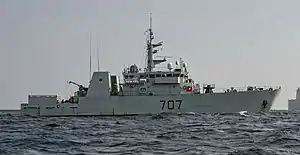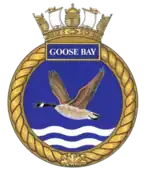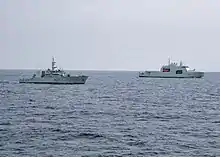HMCS Goose Bay
HMCS Goose Bay is a Kingston-class coastal defence vessel that has served in the Canadian Forces since 1998. Goose Bay is the eighth ship of her class which is the name for the Maritime Coastal Defence Vessel Project. She is the first vessel to be named Goose Bay. The coastal defence vessel is assigned to Maritime Forces Atlantic (MARLANT) and is homeported at CFB Halifax.
 HMCS Goose Bay in March 2022 | |
| History | |
|---|---|
| Name | Goose Bay |
| Namesake | Goose Bay, Labrador |
| Builder | Halifax Shipyards Ltd., Halifax, Nova Scotia |
| Laid down | 22 February 1997 |
| Launched | 4 September 1997 |
| Commissioned | 26 July 1998 |
| Homeport | CFB Halifax |
| Identification |
|
| Status | In active service |
| Badge |  |
| General characteristics | |
| Class and type | Kingston-class coastal defence vessel |
| Displacement | 970 long tons (990 t) |
| Length | 55.3 m (181 ft 5 in) |
| Beam | 11.3 m (37 ft 1 in) |
| Draught | 3.4 m (11 ft 2 in) |
| Propulsion | |
| Speed | 15 knots (28 km/h; 17 mph) |
| Range | 5,000 nmi (9,300 km; 5,800 mi) at 8 kn (15 km/h; 9.2 mph) |
| Complement | 37 |
| Sensors and processing systems |
|
| Armament |
|
Design and description
The Kingston class was designed to fill the minesweeper, coastal patrol and reserve training needs of the Canadian Forces, replacing the Bay-class minesweepers, Porte-class gate vessels and Royal Canadian Mounted Police coastal launches in those roles.[1] In order to perform these varied duties the Kingston-class vessels are designed to carry up to three 6.1-metre (20 ft) ISO containers with power hookups on the open deck aft in order to embark mission-specific payloads.[2] The seven module types available for embarkation include four route survey, two mechanical minesweeping and one bottom inspection modules.[1]
The Kingston class displace 970 long tons (990 t) and are 55.3 metres (181 ft 5 in) long overall with a beam 11.3 metres (37 ft 1 in) and a draught of 3.4 metres (11 ft 2 in).[1] The coastal defence vessels are powered by four Jeumont ANR-53-50 alternators coupled to four Wärtsilä UD 23V12 diesel engines creating 7.2 megawatts (9,700 hp). Two LIPS Z-drive azimuth thrusters are driven by two Jeumont CI 560L motors creating 3,000 horsepower (2,200 kW) and the Z drives can be rotated 360°. This gives the ships a maximum speed of 15 knots (28 km/h; 17 mph) and a range of 5,000 nautical miles (9,300 km; 5,800 mi) at 8 knots (15 km/h; 9.2 mph).[3]
The Kingston class is equipped with a Kelvin Hughes navigational radar using the I band and a Kelvin Hughes 6000 surface search radar scanning the E and F bands. The vessels carry an AN/SQS-511 towed side scan sonar for minesweeping and a Remote-control Mine Hunting System (RMHS). The vessels are equipped with one Bofors 40 mm/60 calibre Mk 5C gun and two M2 machine guns.[3][lower-alpha 1] The 40 mm gun was declared obsolete and removed from the vessels in 2014. Some of them ended up as museum pieces and on display at naval reserve installations across Canada.[4] The Kingston-class coastal defence vessels have a complement of 37.[1]
Service history
Goose Bay's keel was laid down on 22 February 1997 by Halifax Shipyards Ltd. at Halifax, Nova Scotia and was launched on 4 September 1997. The ship was commissioned into the Canadian Forces on 26 July 1998 at Happy Valley-Goose Bay, Newfoundland and Labrador and carries the hull number MM 707.[5]
In Fall 2000, the coastal defence vessel took part in the naval exercise Unified Spirit off the east coast of North America. From 23 April to 9 May 2001, Goose Bay, accompanied by sister ship Moncton, took part in the NATO naval exercise Blue Game off the coasts of Norway and Denmark. In August 2002, Goose Bay and sister ship Summerside sailed to Arctic waters as part of Operation Narwhal Ranger, a military exercise involving all arms of the Canadian Forces. This marked the first Arctic visit by naval vessels in thirteen years.[5]
In August 2010 Goose Bay participated in Operation Nanook 2010, in the Canadian Arctic.[6] This was the fourth annual joint exercise, and the first where foreign vessels participated. In 2012, the vessel deployed as part of Operation Caribbe, Canada's participation in the war on drugs.[7]
In February 2015, Goose Bay was deployed again to Operation Caribbe.[8] In March 2015, as part of Operation Caribbe, Goose Bay, along with sister ship Shawinigan and the US Navy frigate USS Kauffman, intercepted a vessel in the Caribbean Sea carrying 1,017 kilograms (2,242 lb) of cocaine.[9][10] On 8 September 2015, Goose Bay deployed for large NATO naval exercises Joint Warrior and Trident Venture with Athabaskan, Windsor, Montréal, Halifax and Summerside.[11][12] In the summer of 2016, Goose Bay was sent on a goodwill tour of the Great Lakes, making several port visits.[13] In July, Goose Bay visited her namesake port.[14] In September Goose Bay was among the Canadian warships deployed to the NATO naval training exercise "Cutlass Fury" off the east coast of North America.[15]
In June 2017, Goose Bay returned to the Great Lakes and Saint Lawrence Seaway for a goodwill tour, making several port visits.[16][17] In August Montréal and Goose Bay and sister ship Kingston departed Halifax to take part in the Operation Nanook in Canada's northern waters.[18]

In 2019, Goose Bay sailed to the Caribbean to take part in the naval exercise Tradewinds, training with other nation's navies from the area.[19] In 2021, Goose Bay and HMCS Harry DeWolf took part in Operation Nanook.[20] Goose Bay was among the ships deployed to the Arctic for Operation Nanook in August 2022.[21] In September 2022, Goose Bay was tasked for hurricane relief efforts, after Hurricane Fiona's devastating impact to the Maritimes.[22]
References
Notes
- The 60 calibre denotes the length of the gun. This means that the length of the gun barrel is 60 times the bore diameter.
Citations
- Macpherson and Barrie, p. 299
- Saunders (2008), p. 95
- Saunders (2004), p. 92
- Mallett, Peter (17 October 2018). "Big guns find new life". CFB Esquimalt Lookout. Retrieved 31 October 2018.
- Macpherson and Barrie, p. 301
- "Canada Command – OP Nanook". Canadian Forces. August 2010. Archived from the original on 30 November 2010. Retrieved 22 September 2010.
- "Navy assists in large drug bust". CFB Esquimalt Lookout. 10 December 2012. Retrieved 1 October 2014.
- Pugliese, David (2 March 2015). "Four Maritime Coastal Defence Vessels on patrol on OP Caribbe". Ottawa Citizen. Retrieved 3 March 2015.
- "Canada, US navies seize 1,000 kg cocaine in Caribbean". Business Standard. 10 March 2015. Retrieved 10 March 2015.
- Pugliese, David (9 March 2015). "HMCS Goose Bay and HMCS Shawinigan take part in drug bust in Caribbean Sea". Ottawa Citizen. Retrieved 10 March 2015.
- "HMCS Halifax, Athabaskan depart for NATO exercises". CBC News. 8 September 2015. Retrieved 17 December 2015.
- "HMCS Windsor returning to Halifax port after NATO exercises". CBC News. 16 December 2015. Retrieved 17 December 2015.
- Wisniewski, Dominik (27 June 2016). "HMCS Goose Bay defence vessel to visit Cobourg Harbour and offer ship tours". Northumberland News. Retrieved 6 July 2016.
- "One More Day for HMCS Goose Bay in Happy Valley-Goose Bay". VOCM. 24 July 2016. Retrieved 26 July 2016.
- "NATO warships converge on Halifax for military exercises". CTV News. 10 September 2016. Retrieved 11 September 2016.
- Fisher, Pete (6 June 2017). "HMCS Goose Bay returns to Cobourg". Northumberland Today. Retrieved 13 June 2017.
- "HMCS Goose Bay stops in Kingston". CKWS Kingston. 7 June 2017. Retrieved 13 June 2017.
- Pugliese, David (15 August 2017). "Royal Canadian Navy ships to conduct operations in Canada's northern waters". Ottawa Citizen. Retrieved 16 August 2017.
- Channon, Max (27 June 2019). "Royal Navy support ship opens fire and Marines head ashore". devonlive.com. Retrieved 29 June 2019.
- "Operation Nanook 2021 activities begin in Canada's Arctic region" (Press release). Government of Canada. 26 June 2021. Retrieved 4 August 2021.
- "Canadian warships deployed to Arctic for two-month, multinational mission". Global News. The Canadian Press. 2 August 2022. Retrieved 3 August 2022.
- "Ottawa sending Canadian Forces to Newfoundland's southwest coast to help with Fiona cleanup". CBC News. 26 September 2022. Retrieved 27 September 2022.
Sources
- Macpherson, Ken; Barrie, Ron (2002). The Ships of Canada's Naval Forces 1910–2002 (Third ed.). St. Catharines, Ontario: Vanwell Publishing. ISBN 1-55125-072-1.
- Saunders, Stephen, ed. (2004). Jane's Fighting Ships 2004–2005 (107 ed.). Alexandria, Virginia: Jane's Information Group Inc. ISBN 0-7106-2623-1.
- Saunders, Stephen, ed. (2008). Jane's Fighting Ships 2008–2009. Jane's Fighting Ships (111th ed.). Surrey: Jane's Information Group. ISBN 978-0-7106-2845-9. OCLC 225431774.